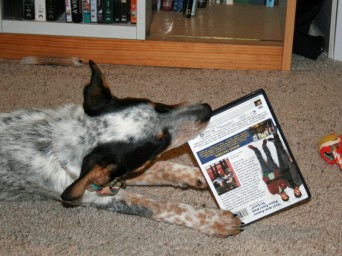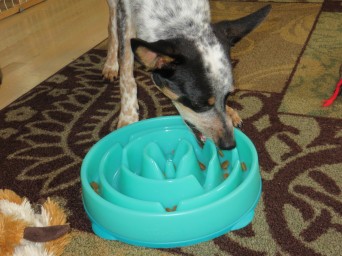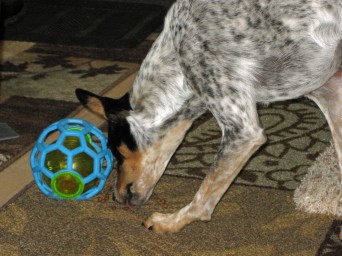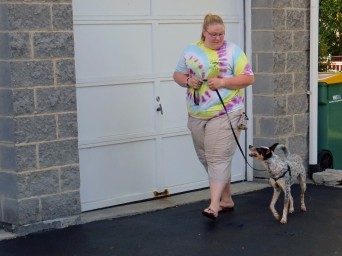 BY TENA PARKER, CPDT-KA
BY TENA PARKER, CPDT-KA
Success Just Clicks
for Lesbian.com
Does your dog drive you crazy with annoying behaviors like barking, stealing things, chewing inappropriate items, jumping up, getting into garbage or cabinets or digging? Does he engage in peculiar behaviors like occasional spinning and tail chasing, licking (himself, others or inanimate things), chasing shadows and lights or pacing?
While some dogs with these behaviors may require extensive behavior modification to help alleviate the symptoms of a bigger problem, many dogs I encounter with these behaviors are simply under stimulated. The dogs are engaging in these behaviors because they aren’t getting the mental exercise they need, so they are creating their own mental work.
The key is to tire out the brain. If given the choice between a mindless five-mile bike ride for my dogs and 40 minutes of mental exercise, I will take the mental exercise every chance I get. If the brain gets tired out, the body will follow, but tiring out the body and not the brain often leads to problematic behaviors. Now, physical exercise is absolutely important for dogs, but mental exercise tends to be more overlooked. Adding physical exercise is pretty straightforward, but adding mental exercise can require some creativity and isn’t always as obvious.
For dogs who are under stimulated, the solutions are generally simple and, with some consistency, changes happen quickly. Here are two simple ways to reduce problematic behavior due to boredom or under stimulation:
1. Ditch the food bowl
 There are many options available that require a dog to mentally and physically work for their meals. Why let Fido simply eat for free from a bowl when you can give them some brain games to earn their meal? There are a huge range in toys that you can use to dispense dry dog food to your dog through play and problem solving—after working for 20 minutes on a challenging toy to get breakfast, many dogs simply take a nap (instead of getting into trouble). There are also a wide range of games that you can play while your dog earns their meals.
There are many options available that require a dog to mentally and physically work for their meals. Why let Fido simply eat for free from a bowl when you can give them some brain games to earn their meal? There are a huge range in toys that you can use to dispense dry dog food to your dog through play and problem solving—after working for 20 minutes on a challenging toy to get breakfast, many dogs simply take a nap (instead of getting into trouble). There are also a wide range of games that you can play while your dog earns their meals.
Hide and Seek is one of my favorite ways to feed my dogs. Hide dry dog food in a room. Let them use their brains to hunt out the food. Eventually, you can expand to your dog having to search the whole house for their meal or even the yard. It’s pretty easy to set up and dogs love the game.
There are countless food dispensing toys available on the market that are fantastic options for dogs earning their daily meals. When introducing toys, it’s best to start with easy ones first so your dog builds skills they need to solve harder toys and build stamina for toys that won’t pay out as fast. Here is a very small sampling of the toys available.
 Ultra Easy Toys
Ultra Easy Toys
Kyjen Slo-Bowl (pictured), Kong Classic, empty Gatorade bottle with 3+ quarter-sized holes cut in the side.
Easy Toys
Kong Wobbler, Kong Genius toys, Hol-ee Treat Ball, Rockin Treat Ball, Tricky Treat Ball, Planet Dog balls/Orbee
Moderate Toys
Treatstik, Atomic Treat Ball, Kong Satelite, IQ treat ball (on the easy setting), Buster Cube (on the easy setting), Gatorade bottle with one nickel-size hole with lid on.
Challenging toys
Buster Cube, IQ Treat Ball, Gatorade bottle with one kibble-size hole on the bottom.
2. Train That Doggie
Training does two very important jobs, it helps your dog learn better life skills (or crazy tricks) and it tires them out mentally. You don’t even have to spend hours training your dog at all! How about 15 minutes? If you trained your dog during every commercial break during an hourlong TV show, you’d end up training for just about 15 minutes without changing your schedule at all. You can even multitask by using part of your dog’s daily food as training treats so you can feed your dog while working your dog.
 What you train isn’t all that important (manners, obedience, tricks, sports), though there are lots of skills that will work the body as much as the brain. Some of my favorite tricks that work the body as much as the brain are: sit pretty, bow (like a play bow), spinning both directions, rollover, come when called and a hand target (touching their nose to my hand). Put this all together and mix them up for a fast-paced series of position changes and dogs end up panting and mentally tired.
What you train isn’t all that important (manners, obedience, tricks, sports), though there are lots of skills that will work the body as much as the brain. Some of my favorite tricks that work the body as much as the brain are: sit pretty, bow (like a play bow), spinning both directions, rollover, come when called and a hand target (touching their nose to my hand). Put this all together and mix them up for a fast-paced series of position changes and dogs end up panting and mentally tired.
Basically, the more you have your dog working with positive things, the less they will be working with not so positive things. Whether that is an enrichment toy, a puzzle game, a training game or a training class, get your dog thinking and working!
Tena Parker, M.S., has been working with dogs for over 10 years. She is the owner of Success Just Clicks Dog Training in Pittsburgh, PA, has a thriving daily dog blog online, is a member of the APDT (Association of Pet Dog Trainers), is a Certified APDT C.L.A.S.S Evaluator (and instructor), is a Certified AKC Canine Good Citizen and S.T.A.R. Puppy Evaluator, and is a Certified Mentor Trainer for Animal Behavior College. She also teaches popular dog training classes through Western Pennsylvania Humane Society’s Get Smart! Training School several days a week.






